turn signal GMC SAVANA 1998 User Guide
[x] Cancel search | Manufacturer: GMC, Model Year: 1998, Model line: SAVANA, Model: GMC SAVANA 1998Pages: 388, PDF Size: 20.04 MB
Page 180 of 388
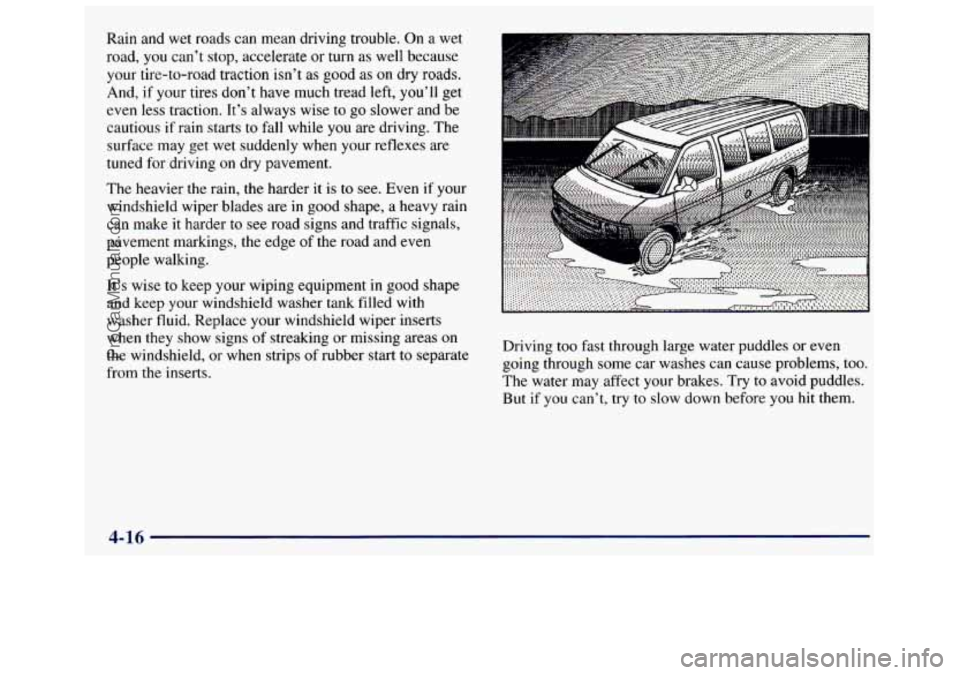
Rain and wet roads can mean driving trouble. On a wet
road,
you can’t stop, accelerate or turn as well because
your tire-to-road traction isn’t as good as
on dry roads.
And, if your tires don’t have much tread left, you’ll ge\
t
even less traction. It’s always wise to
go slower and be
cautious
if rain starts to fall while you are driving. The
surface may get wet suddenly when your reflexes are
tuned for driving on dry pavement.
The heavier the rain, the harder it
is to see. Even if your
windshield wiper blades are in good shape, a heavy rain
can make it harder to see road signs and traffic signals,
pavement markings, the edge of the road and even
people walking.
It’s wise to keep your wiping equipment in good shape
and keep your windshield washer tank filled with
washer fluid, Replace your windshield wiper inserts
when they show signs
of streaking or missing areas on
the windshield, or when strips of rubber start to separate
from the inserts.
..... . .., . A. 4
Driving too fast through large water puddles or even
going through some car washes can cause problems, too.
The water may affect your brakes. Try to avoid puddles.
But if you can’t, try to slow down before you hit them.
4-16
ProCarManuals.com
Page 182 of 388
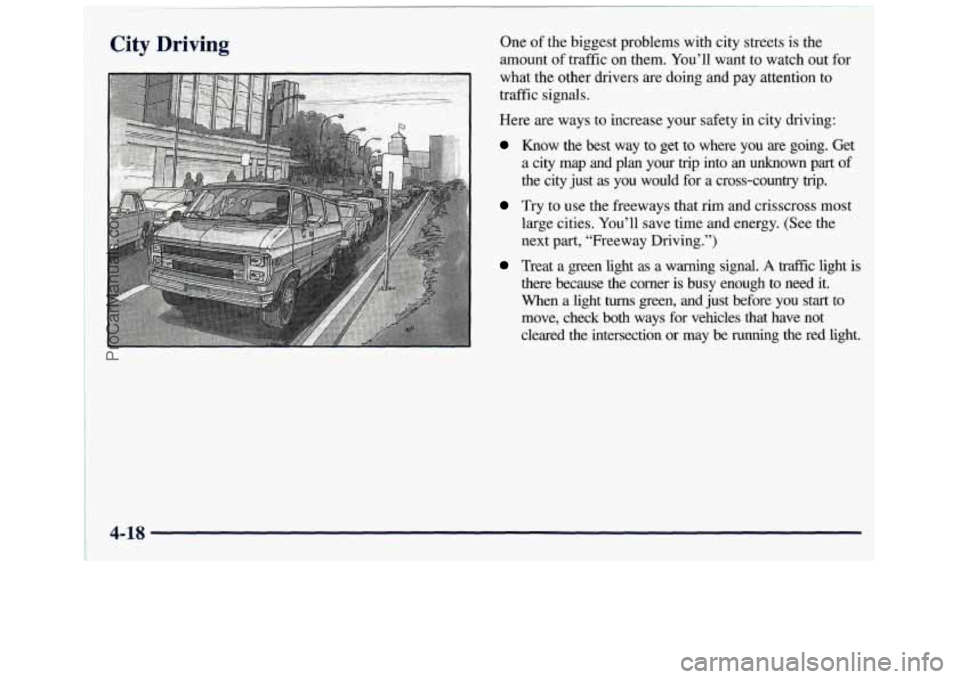
City Driving One of the biggest problems with city streets is the
amount of traffic on them. You’ll want to watch out for
what the other drivers are doing
and pay attention to
traffic signals.
Here
are ways to increase your safety in city driving:
Know the best way to get to where you are going. Get
a city map and plan your
trip into an unknown part of
the city just as you would for a cross-country trip.
Try to use the freeways that rim and crisscross most
large cities. You’ll save time and energy. (See the
next part, “Freeway Driving.”)
there because the comer is busy enough to need it.
When a light turns green,
and just before you start to
move, check both ways for vehicles that have not
cleared the intersection or may
be running the red light.
Treat a green light as a warning signal. A traffic light is I r
4-18
ProCarManuals.com
Page 183 of 388
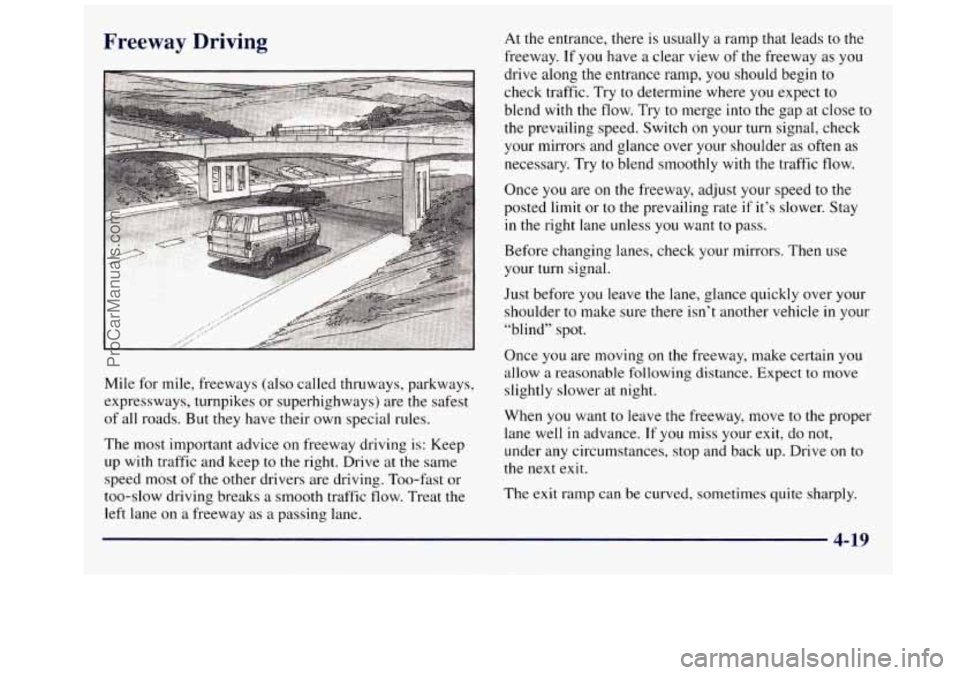
Freeway Driving
Mile for mile, freeways (also called thruways, parkways,
expressways, turnpikes or superhighways) are the safest
of all roads. But they have their own special rules.
The most important advice on freeway driving is: Keep
up with traffic and keep
to the right. Drive at the same
speed most of the other drivers are driving. Too-fast
or
too-slow driving breaks a smooth traffic flow. Treat the
left lane on
a freeway as a passing lane. At the
entrance, there
is usually a ramp that leads to the
freeway. If you have
a clear view of the freeway as you
drive along the entrance ramp, you should begin to
check traffic. Try to determine where you expect to
blend with
the flow. Try to merge into the gap at close to
the prevailing speed. Switch on your turn signal, check
your mirrors and glance over your shoulder
as often as
necessary. Try to blend smoothly with the traffic flow.
Once you are on the freeway, adjust your speed to the
posted limit or to the prevailing rate if it’s slower. Stay
in the right lane unless you want to pass.
Before changing lanes, check your mirrors. Then use
your turn signal.
Just before you leave the lane, glance quickly over your
shoulder to make sure there isn’t another vehicle
in your
“blind” spot.
Once you are moving
on the freeway, make certain you
allow
a reasonable following distance. Expect to move
slightly slower at night.
When you want to leave the freeway, move to the proper
lane well
in advance. If you miss your exit, do not,
under any circumstances, stop and back
up. Drive on to
the next exit.
The exit ramp can be curved, sometimes quite sharply.
4-19
ProCarManuals.com
Page 199 of 388
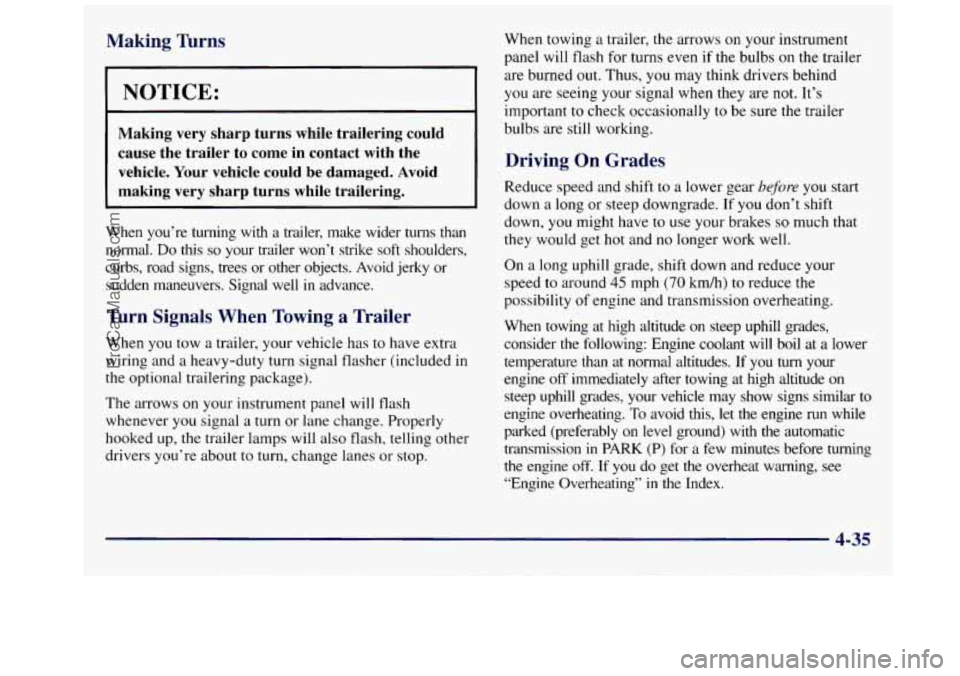
Making Turns
NOTICE:
Making very sharp turns while trailering could cause the trailer to come in contact with the vehicle. Your vehicle could be damaged. Avoid
making very sharp turns while trailering.
When you’re turning with a trailer, make wider turns than
normal.
Do this so your trailer won’t strike soft shoulders,
curbs, road signs, trees or other objects. Avoid jerky or
sudden maneuvers. Signal well
in advance.
Turn Signals When Towing a Trailer
When you tow a trailer, your vehicle has to have extra
wiring and a heavy-duty turn signal flasher (included in
the optional trailering package).
The arrows on your instrument panel will flash
whenever you signal
a turn or lane change. Properly
hooked up, the trailer lamps will also flash, telling other
drivers you’re about
to turn, change lanes or stop. When towing
a trailer,
the arrows on your instrument
panel
will flash for turns even if the bulbs on the trailer
are burned out. Thus, you may think drivers behind
you are seeing your signal when they are not. It’s
important to check occasionally
to be sure the trailer
bulbs are still working.
Driving On Grades
Reduce speed and shift to a lower gear before you start
down a long or steep downgrade. If you don’t shift
down, you might have
to use your brakes so much that
they would get hot and
no longer work well.
On a long uphill grade, shift down and reduce your
speed to around
45 mph (70 km/h) to reduce the
possibility of engine and transmission overheating.
When towing at high altitude on steep uphill grades,
consider the following: Engine coolant will boil at a lower
temperature than at normal altitudes. If you turn your
engine
off immediately after towing at high altitude on
steep uphill grades, your vehicle may show signs similar to
engine overheating.
To avoid this, let the engine run while
parked (preferably
on level ground) with the automatic
transmission
in PARK (P) for a few minutes before turning
the engine off. If you do get
the overheat warning, see
“Engine Overheating” in
the Index.
4-35
ProCarManuals.com
Page 201 of 388
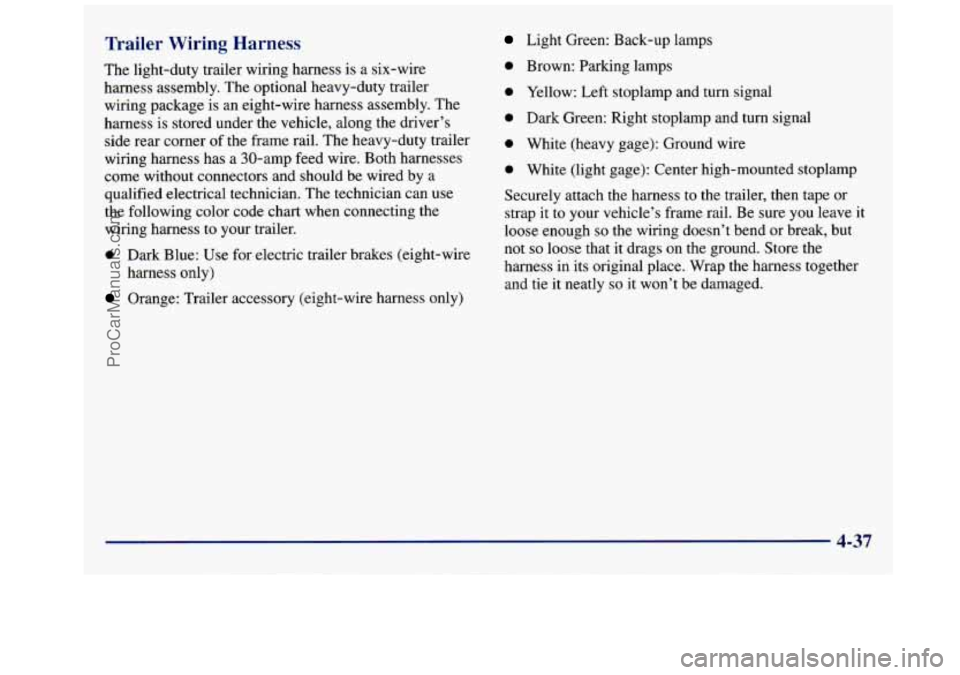
Trailer Wiring Harness
The light-duty trailer wiring harness is a six-wire
harness assembly. The optional heavy-duty trailer
wiring package is
an eight-wire harness assembly. The
harness
is stored under the vehicle, along the driver’s
side rear corner
of the frame rail. The heavy-duty trailer
wiring harness has a 30-amp feed wire. Both harnesses
come without connectors and should be wired by a
qualified electrical technician. The technician can use
the following color code chart when connecting the
wiring harness to your trailer.
0 Dark Blue: Use for electric trailer brakes (eight-wire
harness only)
Orange: Trailer accessory (eight-wire harness only)
Light Green: Back-up lamps
0 Brown: Parking lamps
0 Yellow: Left stoplamp and turn signal
0 Dark Green: Right stoplamp and turn signal
0 White (heavy gage): Ground wire
0 White (light gage): Center high-mounted stoplamp
Securely attach the harness to the trailer, then tape or
strap it to your vehicle’s frame rail. Be sure you leave
it
loose enough so the wiring doesn’t bend or break, but
not
so loose that it drags on the ground. Store the
hamess in its original place. Wrap the harness together
and tie it
neatly so it won’t be damaged.
4-37
ProCarManuals.com
Page 204 of 388
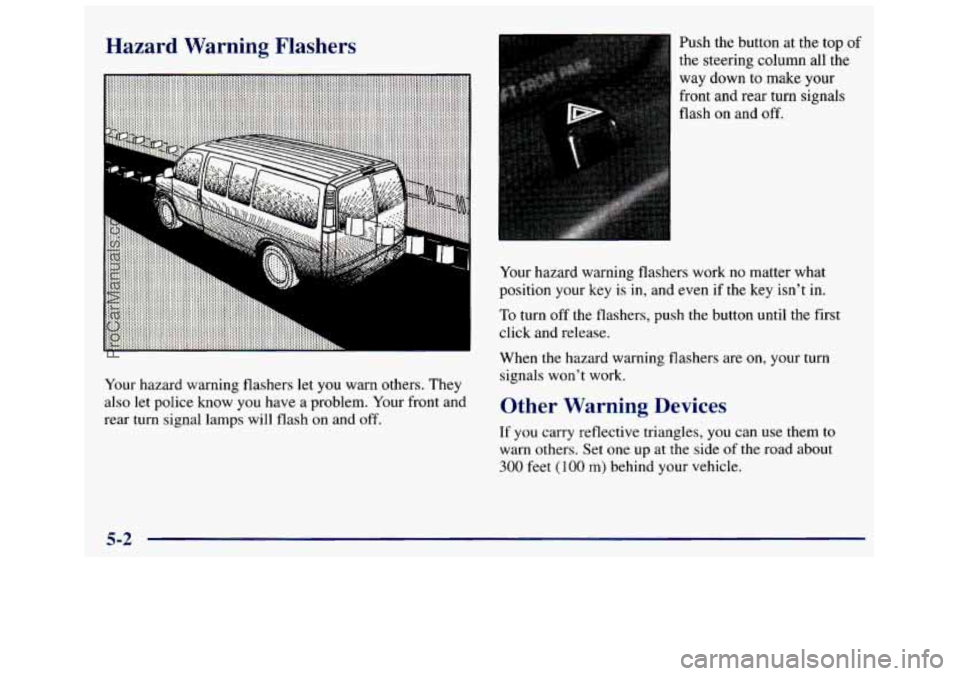
Hazard Warning Flashers
Your hazard warning flashers let you warn others. They
also let police know you have
a problem. Your front and
rear turn signal lamps will flash on and
off.
Push the button at the top of
the steering column all the
way down to
make your
front and rear turn signals
flash on and off.
Your hazard warning flashers work
no matter what
position your key
is in, and even if the key isn’t in.
To turn off the flashers, push the button until the first
click and release.
When the hazard warning flashers are on, your turn
signals won’t work.
Other Warning Devices
If you carry reflective triangles, you can use them to
warn others. Set one up at the side of the road about
300 feet (100 m) behind your vehicle.
5-2
ProCarManuals.com
Page 276 of 388
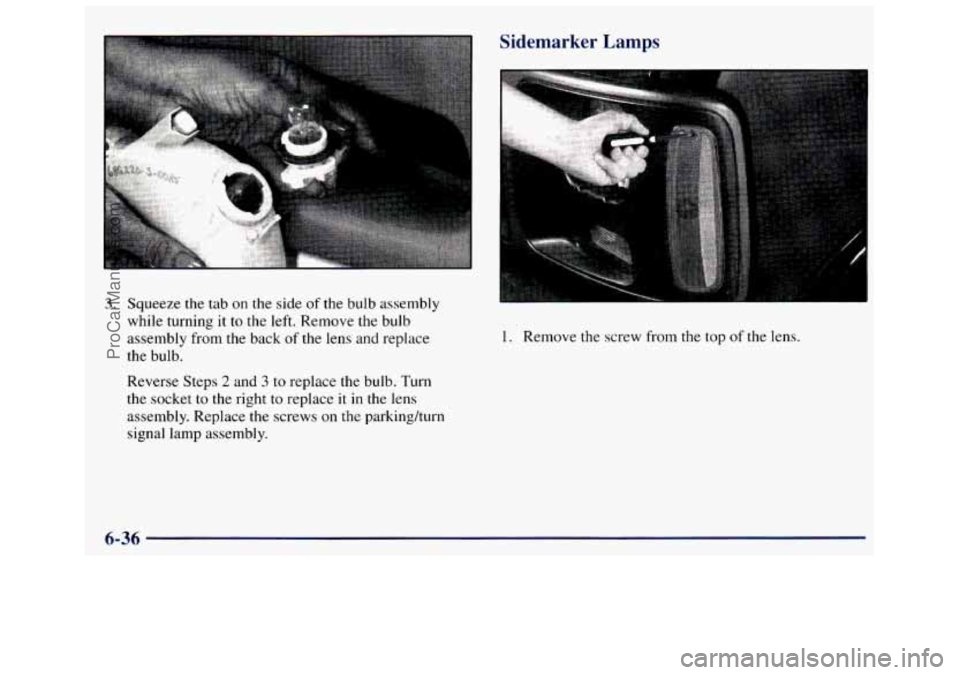
3. Squeeze the tab on the side of the bulb assembly
while turning it to the left. Remove the bulb
assembly from the back
of the lens and replace
the bulb.
Reverse Steps
2 and 3 to replace the bulb. Turn
the socket to the right to replace
it in the lens
assembly. Replace the screws
on the parkingkurn
signal lamp assembly.
Sidemarker Lamps
1. Remove the screw from the top of the lens.
6-36
ProCarManuals.com
Page 383 of 388
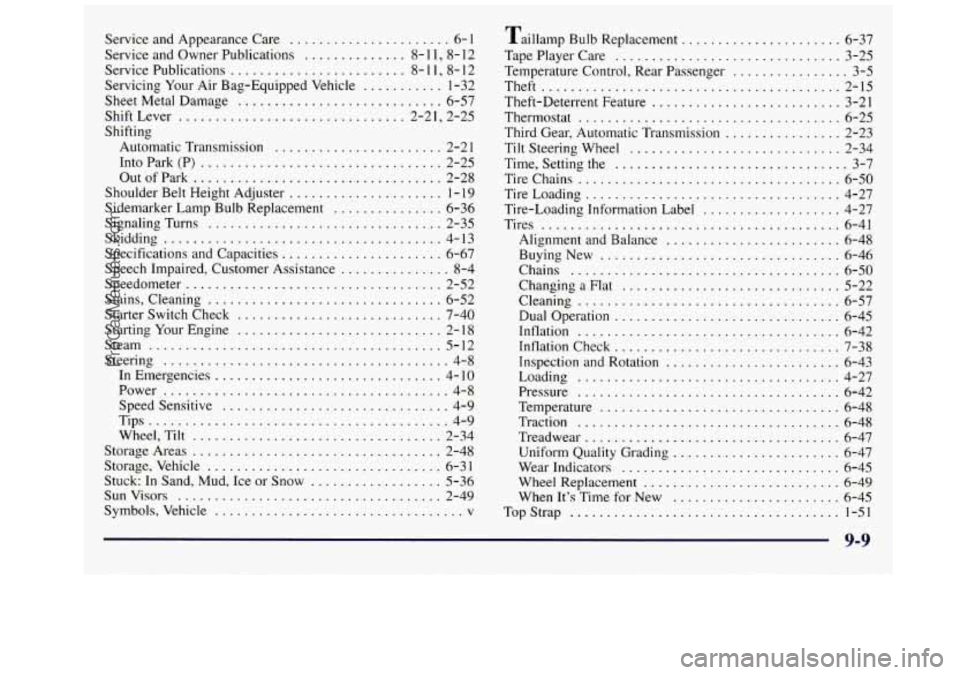
Service and Appearance Care ...................... 6-1
Service and Owner Publications
.............. 8- 1 1. 8. 12
Service Publications
........................ 8- 1 1. 8. 12
Servicing Your
Air Bag-Equipped Vehicle ........... 1-32
Sheet Metal Damage
............................ 6-57
ShiftLever
............................... 2.21. 2.25
Shifting
Automatic Transmission
....................... 2-2 1
Into . Park (P) ................................. 2-25
OutofPark
.................................. 2-28
Sidemarker Lamp Bulb Replacement
............... 6-36
SignalingTurns
................................ 2-35
Skidding
...................................... 4-13
Specifications and Capacities
...................... 6-67
Speech Impaired. Customer Assistance
............... 8-4
Speedometer
................................... 2-52
Stains. Cleaning
................................ 6-52
Starter Switch Check
............................ 7-40
Starting Your Engine
............................ 2- 18
Steam ........................................ 5-12
Steering
....................................... 4-8
In Emergencies
............................... 4- 10
Power ....................................... 4-8
Speedsensitive
............................... 4-9
Tips
......................................... 4-9
Wheel. Tilt
.................................. 2-34
StorageAreas
.................................. 2-48
Storage. Vehicle
................................ 6-3 1
Stuck: In Sand. Mud. Ice or Snow .................. 5-36
Sunvisors
.................................... 2-49
Symbols. Vehicle
.................................. v
Shoulder Belt Height Adjuster ..................... 1 . 19 Taillamp
Bulb Replacement
...................... 6-37
TapePlayerCare
............................... 3-25
Temperature Control. Rear Passenger
................ 3-5
Theft
......................................... 2-15
Theft-Deterrent Feature
.......................... 3-21
Thermostat
.................................... 6-25
Third Gear. Automatic Transmission
................ 2-23
Tilt Steering Wheel
............................. 2-34
Time. Setting the
................................ 3-7
Tire Chains
.................................... 6-50
TireLoading ................................... 4-27
Tire-Loading Information Label
................... 4-27
Tires
......................................... 6-41
Alignment and Balance
........................ 6-48
BuymgNew
................................. 6-46
Chains
..................................... 6-50
Changing
a Flat .............................. 5-22
Cleaning
.................................... 6-57
Dual Operation
............................... 6-45
Inflation
.................................... 6-42
Inflation Check
............................... 7-38
Inspection and Rotation
........................ 6-43
Loading
.................................... 4-27
Pressure
.................................... 6-42
Temperature
................................. 6-48
Traction
.................................... 6-48
Treadwear
................................... 6-47
Uniform Quality Grading
....................... 6-47
Wear Indicators
.............................. 6-45
Wheel Replacement
........................... 6-49
When It’s Time for New
....................... 6-45
TopStrap ..................................... 1-51
9-9
ProCarManuals.com
Page 384 of 388
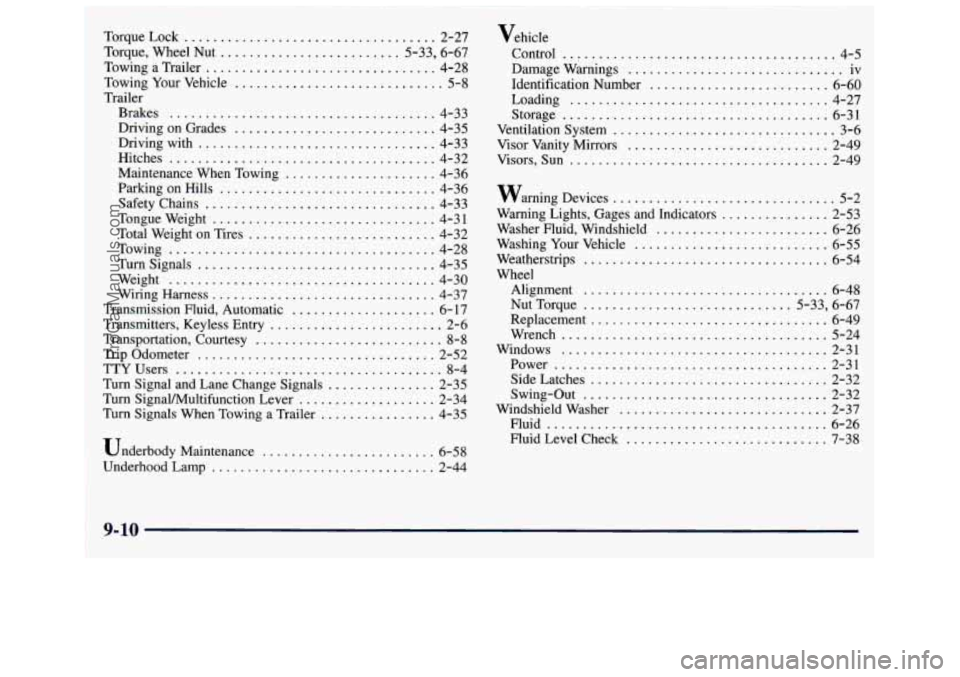
TorqueLock ................................... 2-27
rorque. Wheel Nut ......................... 5.33. 6.67
Towing a Trailer ................................ 4-28
Towing Your Vehicle ............................. 5-8
Driving on Grades ............................ 4-35
Driving with ................................. 4-33
Parking on Hills .............................. 4-36
Safety Chains ................................ 4-33
Tongue Weight ............................... 4-3 1
Total Weight on Tires .......................... 4-32
Towing ..................................... 4-28
Turn Signals ................................. 4-35
Weight ..................................... 4-30
Wiring Harness ............................... 4-37
Transmission Fluid, Automatic .................... 6- 17
rransmitters, Keyless Entry ........................ 2-6
Transportation, Courtesy .......................... 8-8
Trip Odometer ................................. 2-52
Turn SignaVMultifunction Lever ................... 2-34
Trailer
Brakes
...................................... 4-33
Hitches ..................................... 4-32
Maintenance When Towing ..................... 4-36
TTYUsers ..................................... 8-4
Turn Signal and Lane Change Signals ............... 2-35
Turn Signals When Towing a Trailer ................ 4-35
Underbody Maintenance .............. ,. ......... 6-58
Underhood Lamp ............................... 2-44
Vehicle
Control
...................................... 4-5
Damagewarnings .............................. iv
Identification Number
......................... 6-60
Loading .................................... 4-27
Storage ..................................... 6-31
Ventilation System ............................... 3-6
Visor Vanity Mirrors ............................ 2-49
Visors. Sun .................................... 2-49
warning Devices ............................... 5-2
Warning Lights. Gages and Indicators ............... 2-53
Washer Fluid. Windshield ........................ 6-26
Washing Your Vehicle ........................... 6-55
Weatherstrips .................................. 6-54
Wheel
Alignment
.................................. 6-48
Nut Torque ............................. 5-33. 6-67
Replacement ................................. 6-49
Wrench ..................................... 5-24
Windows ..................................... 2-31
Power ...................................... 2-31
SideLatches ................................. 2-32
Swing-Out .................................. 2-32
Windshield Washer ............................. 2-37
Fluid ....................................... 6-26
Fluid Level Check ............................ 7-38
9-10
ProCarManuals.com